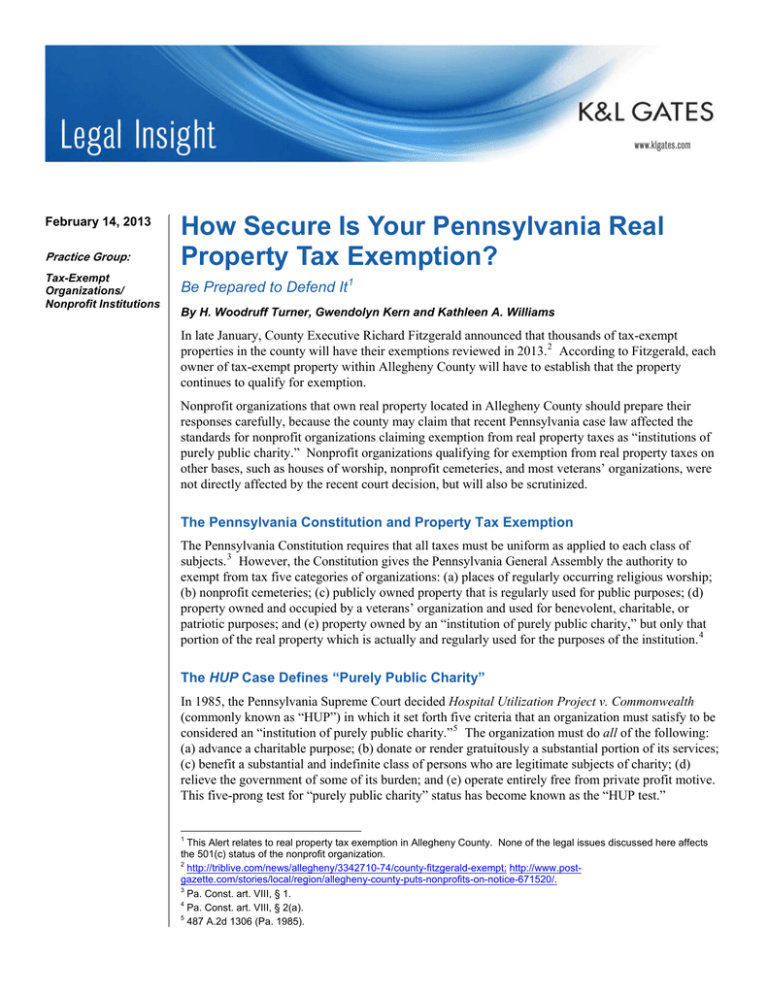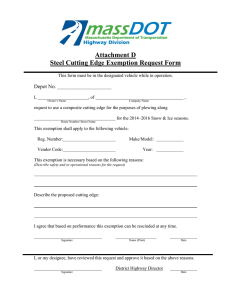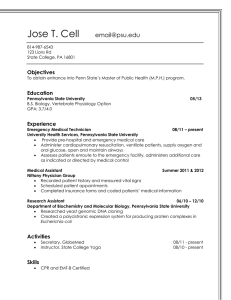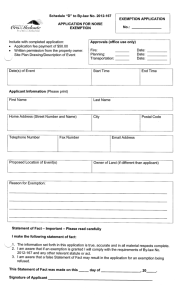
February 14, 2013
Practice Group:
Tax-Exempt
Organizations/
Nonprofit Institutions
How Secure Is Your Pennsylvania Real
Property Tax Exemption?
Be Prepared to Defend It 1
By H. Woodruff Turner, Gwendolyn Kern and Kathleen A. Williams
In late January, County Executive Richard Fitzgerald announced that thousands of tax-exempt
properties in the county will have their exemptions reviewed in 2013. 2 According to Fitzgerald, each
owner of tax-exempt property within Allegheny County will have to establish that the property
continues to qualify for exemption.
Nonprofit organizations that own real property located in Allegheny County should prepare their
responses carefully, because the county may claim that recent Pennsylvania case law affected the
standards for nonprofit organizations claiming exemption from real property taxes as “institutions of
purely public charity.” Nonprofit organizations qualifying for exemption from real property taxes on
other bases, such as houses of worship, nonprofit cemeteries, and most veterans’ organizations, were
not directly affected by the recent court decision, but will also be scrutinized.
The Pennsylvania Constitution and Property Tax Exemption
The Pennsylvania Constitution requires that all taxes must be uniform as applied to each class of
subjects. 3 However, the Constitution gives the Pennsylvania General Assembly the authority to
exempt from tax five categories of organizations: (a) places of regularly occurring religious worship;
(b) nonprofit cemeteries; (c) publicly owned property that is regularly used for public purposes; (d)
property owned and occupied by a veterans’ organization and used for benevolent, charitable, or
patriotic purposes; and (e) property owned by an “institution of purely public charity,” but only that
portion of the real property which is actually and regularly used for the purposes of the institution. 4
The HUP Case Defines “Purely Public Charity”
In 1985, the Pennsylvania Supreme Court decided Hospital Utilization Project v. Commonwealth
(commonly known as “HUP”) in which it set forth five criteria that an organization must satisfy to be
considered an “institution of purely public charity.” 5 The organization must do all of the following:
(a) advance a charitable purpose; (b) donate or render gratuitously a substantial portion of its services;
(c) benefit a substantial and indefinite class of persons who are legitimate subjects of charity; (d)
relieve the government of some of its burden; and (e) operate entirely free from private profit motive.
This five-prong test for “purely public charity” status has become known as the “HUP test.”
1
This Alert relates to real property tax exemption in Allegheny County. None of the legal issues discussed here affects
the 501(c) status of the nonprofit organization.
2
http://triblive.com/news/allegheny/3342710-74/county-fitzgerald-exempt; http://www.postgazette.com/stories/local/region/allegheny-county-puts-nonprofits-on-notice-671520/.
3
Pa. Const. art. VIII, § 1.
4
Pa. Const. art. VIII, § 2(a).
5
487 A.2d 1306 (Pa. 1985).
How Secure Is Your Pennsylvania Real Property Tax
Exemption?
The HUP test formed the backdrop for Pennsylvania property tax exemption decisions from 1985 to
1997. Whether an organization met each of the five criteria of the HUP test was decided on a factspecific basis, and the body of case law developed under this test is inconsistent. To remedy this
problem, the General Assembly sought to clarify the meaning of “purely public charity.”
The Institutions of Purely Public Charity Act (Act 55)
In 1997, the General Assembly passed the Institutions of Purely Public Charity Act (Act 55 of 1997,
commonly known as “Act 55”). 6 Act 55 was intended to codify the existing criteria for “institutions
of purely public charity” in a way that would eliminate inconsistent application of standards by
providing uniform grounds for exemption. 7
Act 55 listed the five HUP criteria and specified how an institution can prove that it satisfies each
criterion. For example, an organization can meet the requirement that it donate or render gratuitously
a substantial portion of its services under Act 55 by proving that it satisfies one of seven alternative
tests, including that it provides completely free goods or services to at least 5% of the people receiving
goods or services from the organization, or that uncompensated goods or services make up at least 5%
of its aggregate costs of providing goods or services. 8 Act 55 governed property tax exemption
applications from 1997 to 2012. Act 55 has been criticized by taxing bodies for affording “purely
public charity” status too liberally, resulting in the loss of an excessive amount of tax revenue for
municipalities.
How the Bobov Case Impacted Act 55
In 2012, the Pennsylvania Supreme Court in Mesivtah Eitz Chaim of Bobov, Inc. v. Pike Cty. Bd. of
Assessment Appeals (referred to here as “Bobov”) held that the courts were not bound by the
legislature’s interpretation of the Pennsylvania Constitution, and therefore, the provisions of Act 55
interpreting the HUP test did not supersede Pennsylvania decisional law. 9
Bobov held that a summer camp operated by an orthodox Jewish community could not rely upon Act
55 alone to show that it relieved the government of some of its burden. 10 As a result, the camp was
held not to be an “institution of purely public charity,” and the property owned by the camp was not
exempt from tax. In so holding, the court stated that “Article VIII, § 2 was designed not to grant, but
limit, legislative authority to create tax exemptions” and that “Act 55 . . . cannot excuse the
constitutional minimum—if you do not qualify under the HUP test, you never get to the statute.” 11 As
a result, a nonprofit organization seeking property tax exemption in Pennsylvania can no longer be
confident that courts will make reference to the more expansive construction of Act 55 when
determining whether the organization satisfies all of the HUP criteria.
Bobov was decided by a 4–3 margin, and three of the justices joined in a lengthy dissent in which they
argued that the provisions of Act 55 that do not conflict with the Pennsylvania Constitution should
remain operational. It will remain for future court decisions to define the residual role of Act 55.
6
10 P.S. § 371 et seq.
10 P.S. § 372(b).
8
10 P.S. § 375(d)(1).
9
44 A.3d 3 (Pa. 2012).
10
Id. at 9.
11
Id. at 8–9.
7
2
How Secure Is Your Pennsylvania Real Property Tax
Exemption?
The Upcoming Property Tax Exemption Review
In 2007, the Allegheny County Council enacted legislation that required the Office of Property
Assessment to review all property tax exemptions granted to nonprofits every three years, 12 but no
reviews have been conducted. The issue was raised again in June 2012, when Allegheny County
Controller Chelsa Wagner released a “Taxpayer Alert” in which she wrote that the Bobov decision
“opens the door to taxing bodies across the Commonwealth exploring options for challenging property
tax exemptions to generate additional revenues.” 13 Wagner indicated that major health care,
educational, and cultural institutions could provide millions of dollars in additional revenue to
Allegheny County as well as municipalities and school districts within the county. In January 2013,
County Executive Richard Fitzgerald announced that the county planned to require all 9,000 nongovernmental owners of properties located within the county that are currently exempt from real
property tax to reestablish their eligibility for exemption.
What Pennsylvania Nonprofits Seeking Property Tax Exemptions Should Do
While County Executive Fitzgerald has not announced precisely when the review process will begin,
nonprofit organizations owning real property in Allegheny County should be prepared to respond to
inquiries regarding their eligibility for property tax exemption. When responding to such an inquiry,
each nonprofit should fashion its reply carefully to fall under at least one of the constitutional
categories.
When seeking to qualify as a “purely public charity,” a nonprofit organization should show how it
meets each of the five criteria of the HUP test. In past cases, courts have considered the following
factors, among others:
Advance a charitable purpose. An organization may be considered to advance a charitable
purpose if the organization “benefits the public from an educational, religious, moral, physical, or
social standpoint.”14
Donate or render gratuitously a substantial portion of its services. There is no set percentage to
determine whether an organization donates or renders gratuitously a substantial portion of its
services.15 Rather, this determination is based on the totality of the organization’s circumstances,
including financial aid given, services to the community, and the organization’s use of
volunteers.16 The organization should make a bona fide effort to serve primarily those who
cannot afford the organization’s fee.17
Benefit a substantial and indefinite class of persons who are legitimate subjects of charity. The
organization must benefit an indefinite, unrestricted class of persons.18 The organization must
directly provide services to those in need.19
12
ALLEGHENY COUNTY, PA., CODE OF ORDINANCES § 5-210.12 (2012).
http://www.alleghenycounty.us/news/2012/20120625a_taxExempt.pdf.
14
City of Washington v. Bd. of Assessment Appeals, 704 A.2d 120, 122 (Pa. 1997).
15
In re Sewickley Valley YMCA Decision of Bd. of Prop. Assessment, 774 A.2d 1, 8 (Pa. Commw. Ct. 2001) (relying on
pre-Act 55 authority).
16
Id.
17
Id.
18
Unionville-Chadds Ford School Dist. v. Chester Cnty. Bd. of Assessment Appeals, 714 A.2d 397, 401 (Pa. 1998).
19
Sacred Heart Healthcare Sys. v. Commonwealth, 673 A.2d 1021, 1027 (Pa. Commw. Ct. 1996).
13
3
How Secure Is Your Pennsylvania Real Property Tax
Exemption?
Relieve the government of some of its burden. An organization may be found to relieve the
government of some burden if it “bear[s] a substantial burden that otherwise would fall to the
government.”20 Some courts have held this test to be satisfied even without fully funding the care
of any person whose care otherwise would be funded by the government.21 Organizations have
passed this test despite accepting available government payments that cover part of their costs and
without providing services entirely free of charge.22
Operate entirely free from private profit motive. An organization need not be insolvent or
bankrupt to show that it operates entirely free from private profit motive.23 Courts have
considered whether the organization made a profit and whether it paid excessive salaries or fringe
benefits to its officers.24 A charity is not converted into a profit-making entity merely because it
runs a surplus.25
A nonprofit organization receiving an unfavorable determination regarding the tax-exempt status of its
real property located in Allegheny County may appeal to the Allegheny County Board of Property
Assessments, Appeals & Review and ultimately the courts.
In the current climate, nonprofits should not handle this issue in a perfunctory manner, but with
careful attention. Legal counsel could be valuable in connection with any of the steps contemplated
under this review, from preparing an initial response to an inquiry to conducting any subsequent
appeals.
Authors:
H. Woodruff Turner
woodruff.turner@klgates.com
+1.412.355.6478
Gwendolyn Kern
gwendolyn.kern@klgates.com
+1.412.355.8919
Kathleen A. Williams
kathleen.williams@klgates.com
+1.412.355.7408
Anchorage Austin Beijing Berlin Boston Brisbane Brussels Charleston Charlotte Chicago Dallas Doha Dubai Fort Worth Frankfurt
Harrisburg Hong Kong Houston London Los Angeles Melbourne Miami Milan Moscow Newark New York Orange County Palo Alto Paris
20
Id.
St. Margaret Seneca Place v. Bd. of Property Assessment, Appeals & Review, 640 A.2d 380, 385 (Pa. 1994).
22
Lehighton Area School Dist. v. Carbon Cnty. Bd. of Assessment, 708 A.2d 1297, 1304 (Pa. Commw. Ct. 1998).
23
Couriers-Susquehanna, Inc. v. Dauphin Cnty. Bd. of Assessment Appeals, 693 A.2d 626, 631 (Pa. Commw. Ct. 1997).
24
St. Joseph Hosp. v. Berks Cnty. Bd. of Assessment Appeals, 709 A.2d 928, 937 (Pa. Commw. Ct. 1998).
25
Couriers-Susquehanna, Inc., 693 A.2d at 632.
21
4
How Secure Is Your Pennsylvania Real Property Tax
Exemption?
Perth Pittsburgh Portland Raleigh Research Triangle Park San Diego San Francisco São Paulo Seattle Seoul Shanghai Singapore Spokane
Sydney Taipei Tokyo Warsaw Washington, D.C.
K&L Gates practices out of 47 fully integrated offices located in the United States, Asia, Australia, Europe, the
Middle East and South America and represents leading global corporations, growth and middle-market companies,
capital markets participants and entrepreneurs in every major industry group as well as public sector entities,
educational institutions, philanthropic organizations and individuals. For more information about K&L Gates or its
locations, practices and registrations, visit www.klgates.com.
This publication is for informational purposes and does not contain or convey legal advice. The information herein should not be used or relied upon in
regard to any particular facts or circumstances without first consulting a lawyer.
©2013 K&L Gates LLP. All Rights Reserved.
5




